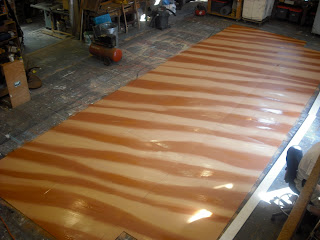So it is safe to assume that when you are doing Forever Plaid that a lot of plaid will be involved. The plaid in question came in the form of a drop. At first it seemed like a very daunting task, considering our two week build for the show which also included a painted scrim portal. However, through the sampling process we came up with a great process and the drop only took about two days to finish.
Below is the designers elevation for the drop. The main challenge was figuring out how to layer the plaid design properly. The issue of paint consistency was also a challenge. The consistency had to be enough to cover but also transparent enough to play with the colors of the lines below.

This is a sample board that I made to figure out the layering and paint consistency. The colors in the sample are different than the final drop because I was mixing to a small elevation. We later got an elevation from the designer that included paint chips which we mixed to.

After our layering process had been figured out it was time to begin layout. We created story sticks for each section of lines to help with the layout and make sure we kept everything the same. Since the tiny white lines were very small, only about an inch, and on the top layer we decided to base the drop white. We then taped out the white lines so at the end we could just pull the tape and have our lines without having to paint them. The rest of the drop was then based blue since that was the next layer in our process.

We decided that the plaid had three layers, more or less. Below is a picture after the first layer had been finished. The small white tape was used to separate the small red lines because they were not continuous in the design, but it was easier to just mask them using tape and paint a continuous line.

Below is the drop after the second layer was completed. We had some dry time and really wanted to pull up the tape for the white lines.... so we did. Even though the white lines were on the top layer, we could pull the tape at this stage because no other lines interacted with them. *Sidenote: Some very sweet and deadly tape balls were made after this step!
The last and final layer! We applied our lines in two fashions - using brushes and lining sticks and also masking/spraying with a cup gun. Most of the horizontal lines were done using the cup gun while the vertical lines were done with a brush. Ideally the whole drop would have been done with the cup gun because the designer wanted a very crisp, graphic look. But the vertical sections were so intricate it would have taken too long to mask. So we compromised.

The final step was a few sprays to even everything out and blend the drop together nicely. Here's an up close photo.

Here is a picture that I took during a rehearsal of the drop in action. The plaid was the same as the actors jackets, which was fun... everything matched! They were still adjusting lighting cues so the drop is a little dark. I'll have to get some better photos with the moon out of the way.



























